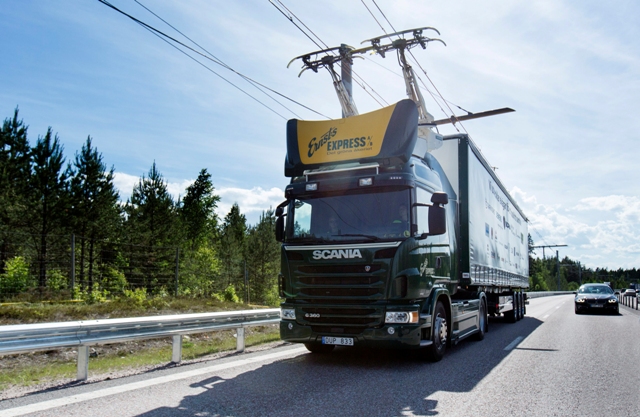
When Mercedes-Benz parent company Daimler during its recent TecDay issued statements about the absolute need to electrify cars, light trucks, and even city buses, it stated that there was no plan in place for trucks. It’s easy to say, “Just add batteries, like with cars,” but the battery mass and weight to haul around 4,000 to 6,000 pounds of vehicle and passengers in a typical car or light truck pales in comparison to what it would take to move a tractor trailer with 80,000 pounds of freight over long distances. So the solution for “greening-up” trucks has remained an unsolved challenge.
Swedish firms Siemens and Scania are testing an electrical system with the potential for solving at least part of the big truck/big carbon question. German Siemens AG and Swedish heavy-vehicle maker Scania AB have teamed up to test the world’s first e-highway in central Sweden, according to CleanTech Canada.
The test route, which runs for 2 km (about 1.2 miles) uses an overhead wire system called a catenary that provides electrical power. The system is similar to those you might see in some U.S. cities to power trolley cars or electric trains. A device called a pantograph mounted on the roof of the truck moves up and down to automatically maintain a connection to the overhead wires.
Siemens designed the wire system and Scania adapted two trucks with a diesel-hybrid drive capable of running on electric power from the overhead grid when available and automatically switching to diesel power when they move off the overhead grid. The Siemens/Scandia system design lets the trucks switch connections and maintain speeds up to 90 kph (55 miles per hour). Hybrid systems will be imperative during the transformation from fossil fuel to all-electric trucks.
Sweden has pledged to transform its transportation system to run fossil fuel- and emissions-free by 2030, and like the rest of the world depends on trucks. “By far the greatest part of the goods transported in Sweden goes on the road, but only a limited part of the goods can be moved to other traffic types,” said Anders Berndtsson, chief strategist at the Swedish Transport Administration. “That is why we must free the trucks from their dependence on fossil fuels, so that they can be of use also in the future … Electric roads offer this possibility and are an excellent complement to the transport system,” he added.
Siemens is also planning another e-highway test route in California in 2017, the company said.
Editors' Recommendations
- Big EVs are almost here: 7 upcoming electric SUVs we’re excited for
- Ford EV drivers can use 12,000 Tesla Superchargers starting in 2024
- This city’s residents voted to ban electric scooters
- Check out Spectre, Rolls-Royce’s first all-electric car
- 2022 Volkswagen ID. Buzz first drive review: The iconic hippie hauler goes electric




